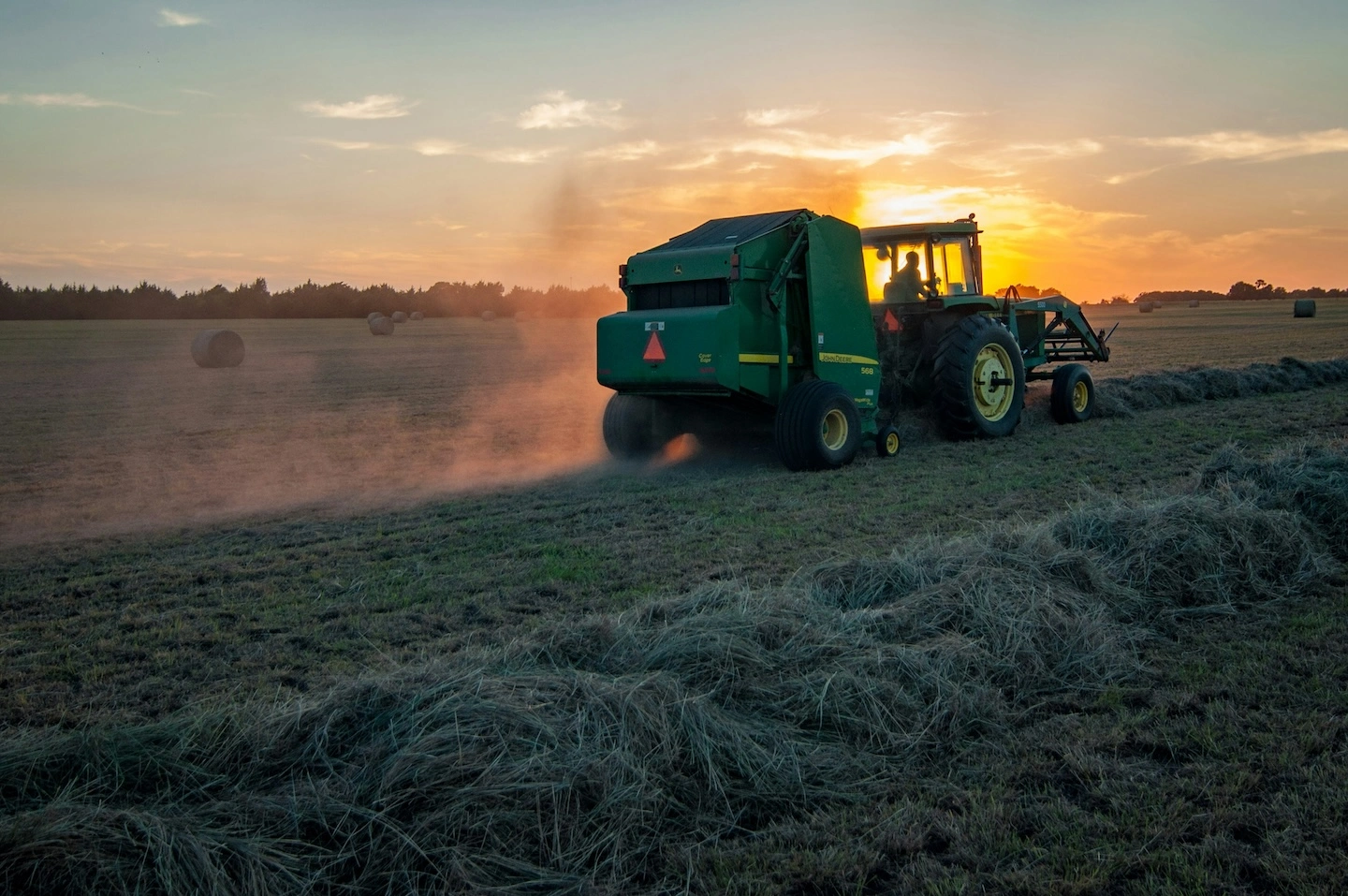Image provided by James Baltz via Unsplash
TL;DR: Agriculture contributes to air pollution through greenhouse gases and particulate matter, including dust (PM10) emissions. Land tilling, unpaved roads, and animal operations release pollutants that harm air quality. Applying water or suppressants, using covers, and maintaining vegetation can help reduce dust. Air quality sensor networks near agricultural sites allow stakeholders to measure air pollutants such as PM10, assess mitigation efforts, and protect the health of workers and nearby communities.
Air pollution from agricultural sources
Agricultural activities generate several types of air pollutants. The use of fossil fuels to power machinery and vehicles releases carbon dioxide, while fertilizers emit nitrous oxide. Livestock operations, such as cattle digestion, also produce methane and ammonia.
Agriculture accounts for roughly 10% of total greenhouse gas emissions in the United States. This sector is responsible for nearly all of the country’s nitrous oxide emissions, and nearly half of its methane emissions. These gases contribute to global warming, which, in turn, can have a major impact on farming and food security.

Particulate matter air pollution from agricultural sources
Another common air pollutant that comes from agriculture is particulate matter. Particulate matter refers to any solid or liquid particles suspended in the air. It is especially dangerous to human health when these particulates are very small. Fumes from fertilizers and animal waste mix in the air with industrial emissions to form tiny solid particles in the atmosphere.
Particulate matter can be categorized based on the size of the particles. Two common categories are PM2.5 and PM10, which are the two types of particulate matter regulated by the US EPA per the National Ambient Air Quality Standards. PM2.5 refers to particulate matter with a diameter of 2.5 micrometers or smaller, while PM10 refers to particulate matter with a diameter of 10 micrometers or smaller. Both kinds of particulates are significantly smaller than the width of a human hair. The latter category, PM10, includes dust particles.

Both kinds of particulate matter produce adverse health effects. PM2.5 is particularly harmful because its incredibly small size allows it to slip past many of the body’s natural defenses. However, PM10 can still penetrate deep into the lungs and lead to respiratory and cardiovascular diseases. It can cause tissue damage, lung inflammation, reduced lung function, increased hospitalization, worsening of asthma, faster disease progression, and reduced life expectancy. PM10 can also create a haze over landscapes that decreases visibility.
Agricultural dust (PM10) air pollution
Dust (PM10) air pollution can come from different aspects of agriculture. For instance, loading and unloading grain storage and silos create fugitive dust particles. Unpaved roads on farms can generate dust, especially when vehicles drive over them.
Much of the agricultural dust comes from disturbing the ground dirt and soil. Tilling and preparing agricultural lands for planting can cause soil particles to fly into the air. Beyond the harmful effects of the particulate matter itself, this dust can carry pathogens such as the fungus Coccidioides immitis, which is found in the soil in arid regions of the southwestern United States. A study by the UC Berkeley School of Public Health exposed a connection between exposure to agricultural dust air pollution and increasing levels of an emerging infectious disease known as Valley fever. Unsustainable land management can even contribute to sand and dust storms, especially in arid and semi-arid regions.

In America’s Great Plains, for instance, agricultural activity and expansion can lead to land degradation, increasing the likelihood of soil erosion and susceptibility to drought. In the 1930s, this phenomenon may have even contributed to the infamous dust storms of the great depression. A study on the North China Plain found that wind erosion from agricultural fields produced 33.8 × 105 tons of PM10 every year, with farmland emissions contributing roughly 13% of atmospheric PM10 dust concentrations during the winter months.
Some parts of the world practice slash-and-burn agriculture, where forest areas are burned and cleared for planting or animal grazing. Then, after a few years of use, the land is usually left to become a natural forest again, and the cycle continues. Agricultural burning produces particulate matter air pollution (both PM2.5 and PM10) as well as other air pollutants that are frequently associated with fires.

Dust emissions can also come from animal agriculture. Dry, uncompacted manure can produce dust when the wind or hooves kick it up. Weather inversions can keep these emissions near the ground, less likely to disperse and dilute in the atmosphere.
Best practices for reducing agricultural PM10 air pollution
Luckily, there are ways to reduce dust and other air pollution generated by agricultural activities. Common dust mitigation strategies across sectors include applying water or maintaining surface moisture, using covers, and installing windbreaks. During material transport, measures such as shortening drop distances, enclosing transfer points, and using dust curtains can also help.
Dust emissions from unpaved roads can be decreased by applying dust suppressants, limiting vehicle traffic, and planting vegetation such as grass. Dust air pollution emissions from fallow fields can be reduced through equipment modification, selective tilling, planting vegetative cover in surrounding areas, using chips and mulches, creating cross-wind ridges, and many more strategies.
Dust abatement measures from cattle feeding operations include appropriate pen design and maintenance, applying water, and properly managing manure. Removing uncompacted manure from corral surfaces helps prevent hooves from kicking up PM10 into the air.

Looking forward: How air quality monitoring can help
By implementing air quality monitoring networks near agricultural sites, stakeholders can assess the effectiveness of dust reduction strategies, monitor policy compliance, conduct accurate PM10 research, and protect the health of both farmworkers and nearby residents. Learn how you can partner with Clarity to implement an air quality sensor network.
